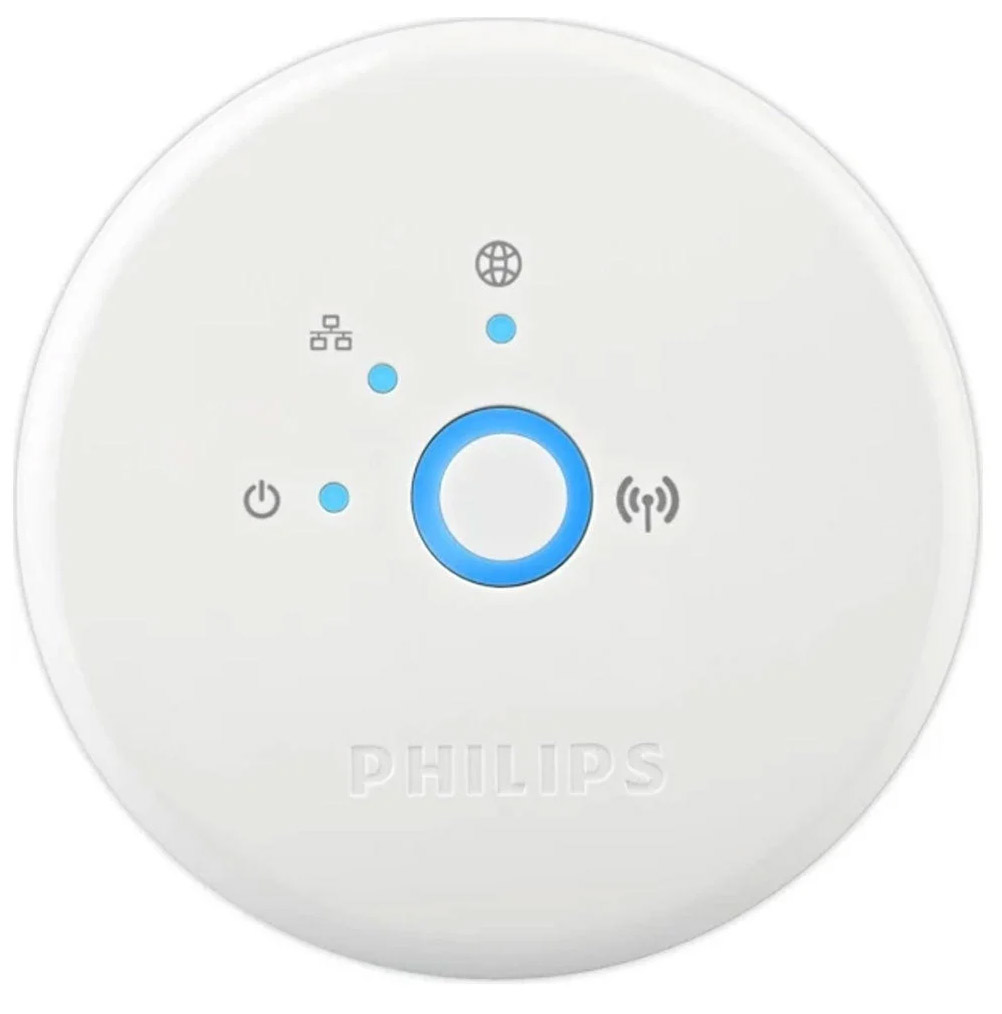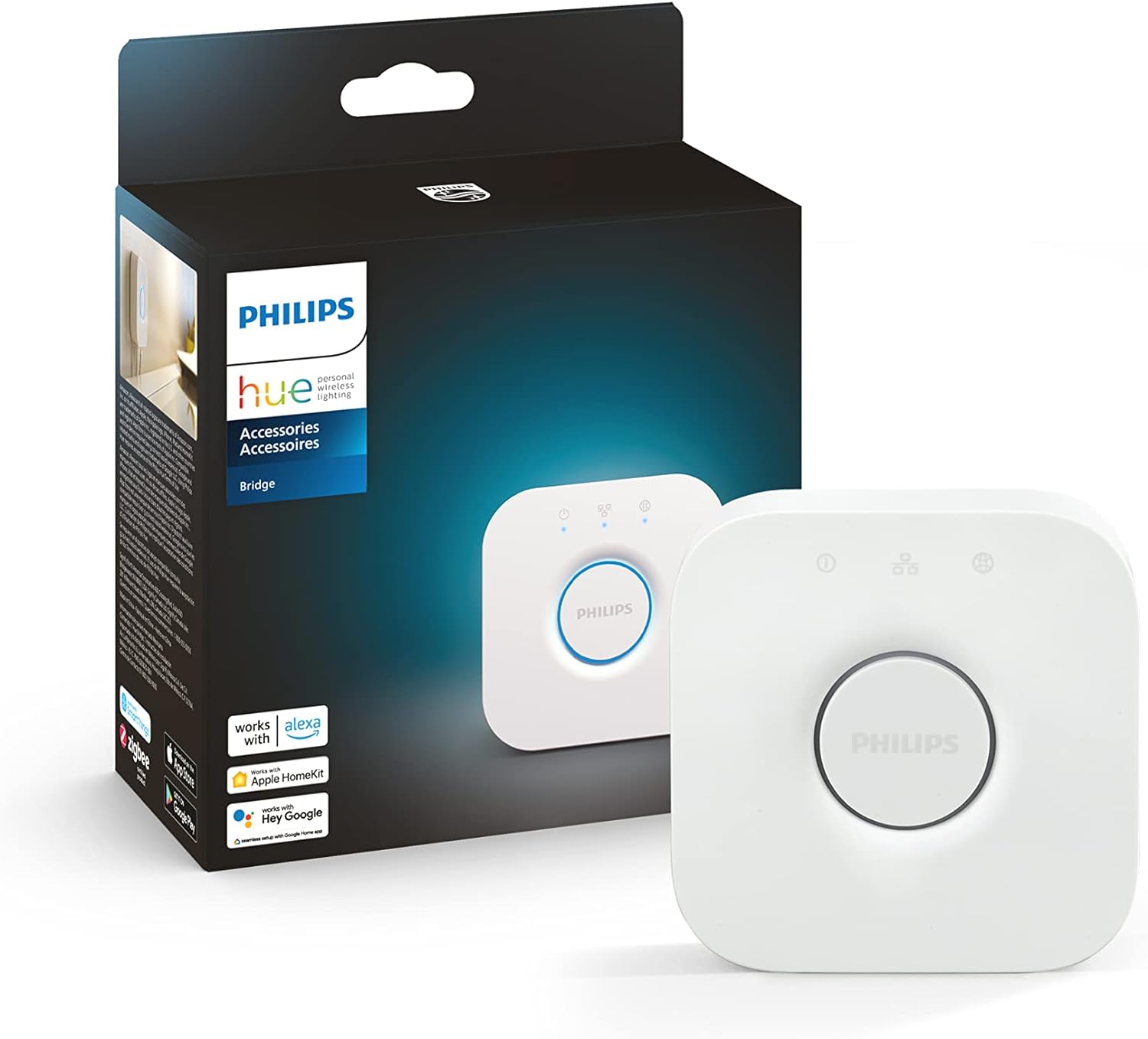Philips Hue is a popular smart lighting system that lets you control your lights from an app, set schedules, and connect with smart home devices. To get the full experience, you need a Hue Bridge. This small hub links your Hue bulbs and accessories to your Wi-Fi and smart home devices like Amazon Echo.
There are two versions of the Hue Bridge: v1 and v2. If you have an older setup or are looking to buy a bridge, you might be wondering about the differences. Let’s go over what each version offers and why Hue Bridge v2 replaced the first one.
👉 Need faster internet? Check out our reviews of the best internet providers.
How Hue Works

Philips Hue lights use Zigbee, a wireless technology that connects smart devices without relying on Wi-Fi. Instead of each bulb connecting directly to your router, all Hue lights and accessories communicate through a Hue Bridge. This keeps your network from slowing down and helps your lights respond quickly. The Hue app acts as the main control center, letting you adjust brightness, set schedules, and create automation.
The system also includes accessories like motion sensors, smart plugs, and dimmer remotes, which work alongside the app for more control. A Hue Bridge can handle up to 50 lights and accessories at once. It also works with smart assistants like Alexa, Google Assistant, and Siri. The latest updates even add support for Matter, a new standard that improves compatibility between different smart home brands.

Hue Bridge v1 Overview

Hue Bridge v1 was the original hub for Philips Hue smart lights. It launched with the first generation of Hue products and connected lights, switches, and sensors using Zigbee. The bridge worked with the Hue app, allowing users to control lights remotely, set schedules, and automate lighting.
You can recognize Hue Bridge v1 by its round design with a light blue ring around the center. It has three indicator lights on the front and an Ethernet port on the back for connecting to a router. At the time, it worked well for controlling up to 50 lights and accessories. However, it didn’t support Apple HomeKit, so Siri voice control wasn’t an option. It also had limited compatibility with newer smart home platforms.
👉 Related reading: Best Streaming Device for Your Home Theater
In April 2020, Philips ended support for Hue Bridge v1. It still works for basic lighting control, but it no longer receives updates or cloud-based features. Remote access, online automation, and other server-dependent functions no longer work. If you want a bridge that supports modern smart home systems and continues to get updates, version 2 is the better choice.
Hue Bridge v2 Overview

Philips released Hue Bridge v2 in 2016 as an upgrade to the first version. It introduced better hardware and support for more smart home systems, including Apple HomeKit.
The Philips Hue Bridge v2 has a square design with rounded edges and a glowing Philips Hue logo in the center. Like v1, it has three indicator lights on the front and an Ethernet port on the back. The updated hardware allows for faster performance and improved connectivity.

- Philips Hue Bridge
- Smart lighting for up to 50 devices
- Reliable Zigbee connection
- Remote control via the app
- Syncs with movies and music
- Supports Matter integration
The biggest advantage of v2 is that it still receives updates. It supports new Philips Hue products, works with smart home platforms like Alexa, Google Assistant, and HomeKit, and is compatible with Matter. Since Philips continues to provide software updates and security patches, v2 is the best option for long-term use.
Main Differences Between Hue Bridge v1 and v2
Hue Bridge Comparison Table
| Feature | Hue Bridge v1 | Hue Bridge v2 | Hue Bluetooth |
|---|---|---|---|
| Release Year | 2012 | 2016 | 2019 |
| Shape | Round | Square | No Bridge |
| Max Lights | 50 | 50 | 10 |
| Apple HomeKit Support | No | Yes | No |
| Smart Home Compatibility | Limited | Alexa, Google, HomeKit | None (without a bridge) |
| Remote Access | No | Yes | No |
| Software Updates | Discontinued (2020) | Ongoing | App-based only |
| Matter Support | No | Yes | No |
| Best For | Basic local control | Full smart home integration | Small setups, single-room use |
Version 2 replaced version 1 for a few reasons. While both bridges support up to 50 Hue lights and accessories, version 2 has better hardware, supports more smart home platforms, and continues to receive updates.
The most noticeable difference is the design. Version 1 is round with a blue ring, while version 2 is square with rounded edges and a glowing Philips Hue logo. If you're not sure which one you have, the shape is the easiest way to tell them apart.
Smart speaker support is another big change. Version 2 supports Apple HomeKit, allowing users to control lights with Siri. Version 1 never had HomeKit support, so it was limited to the Hue app and a few third-party integrations. Version 2 also works better with Amazon Alexa and Google Assistant.
Keep in mind that Philips stopped supporting version 1 in 2020, which means no more updates or security patches are available. Certain features that rely on Philips' servers, like remote access and cloud-based automation, no longer work. Version 2 still gets regular updates and continues to support new features and products.
👉 Related reading: Philips Hue ‘Home and Away’ Not Working?
What About Hue Bluetooth?

- Single A19 bulb, 75W equivalent
- Use Hue Bridge for advanced control
- Offers millions of colors and white light
- Choose preset light scenes for different moods
- Voice control setup via Hue app
If you're not ready to get a Hue Bridge, Philips Hue also has Bluetooth-enabled bulbs that work without one. These bulbs let you control your lights directly from your phone using the Hue Bluetooth app. You can turn them on and off, dim them, and change colors, all within about 30 feet. It’s great for small setups, like a bedroom or a dorm room, where you only need a few smart lights.
Hue lights are also fun for streaming movies. You can open the Hue Bluetooth app and set the lights to a cool blue or deep purple to match the vibe. Or if you’re watching a horror movie, you can dim them down to a creepy red.
The Bluetooth method does have some limits, though. You can only connect up to 10 lights, and they all have to be in the same room. You also have to be nearby to control them, so if you leave home, you won’t be able to adjust your lights remotely. Features like automations, timers, and syncing with music streaming don’t work unless you add a Hue Bridge later.
If you just want a few smart bulbs without dealing with extra hardware, Bluetooth is an easy way to start. But if you want to control lights from anywhere, connect more rooms, or use voice assistants like Alexa and Google Assistant, adding a Hue Bridge gives you the most options.
Is There a Hue Bridge v3?
No, there is no official Hue Bridge v3. Some retailers label certain versions of Hue Bridge v2 as “3rd Gen,” but this is just a hardware revision of v2, not a completely new model. If a new bridge is released in the future, I hope it comes with better hardware and support. Until then, we recommend Hue Bridge v2.
Continue reading:






